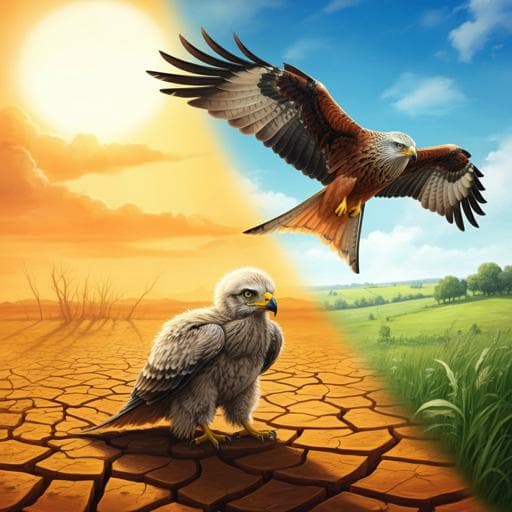
Environmental Studies and Forestry
Hardship at birth alters the impact of climate change on a long-lived predator
F. Sergio, G. Tavecchia, et al.
This fascinating research by Fabrizio Sergio, Giacomo Tavecchia, Julio Blas, Alessandro Tanferna, Fernando Hiraldo, Erkki Korpimaki, and Steven R. Beissinger reveals how natal drought profoundly affects the survival of red kites, with implications for their population dynamics under climate change. Discover how these developmental legacies could reshape our understanding of wildlife resilience!
~3 min • Beginner • English
Introduction
Extreme climate events are increasing in frequency and magnitude and can restructure ecosystems. While many studies assess how contemporary extremes affect adult vital rates and fitness, far fewer quantify the demographic mechanisms and the long-term effects of experiencing extreme conditions during early development. Early-life conditions can shape life-long demographic performance, leading to two contrasting hypotheses: (1) the predictive adaptive response (PAR) hypothesis, where hardship during development may confer advantages if similar conditions are encountered later; and (2) the developmental constraint or silver spoon hypothesis, where hardship during development irreversibly constrains phenotype quality and future fitness regardless of later conditions. These mechanisms can increase heterogeneity in individual quality and inject poorly performing cohorts into populations, potentially altering forecasts of climate impacts if natal effects are ignored. This study examines how drought affects survival and population dynamics of a long-lived avian predator, the red kite Milvus milvus, testing whether natal drought or contemporary drought better predicts survival and population trajectories.
Literature Review
The study builds on extensive evidence that early-life environmental conditions have long-term effects on survival and reproduction across taxa, including fish, reptiles, birds, mammals, and humans. Despite recognition of cohort and silver spoon effects, few studies have integrated natal and contemporary impacts of extreme events in demographic models. The PAR and developmental constraint hypotheses provide contrasting predictions for how early hardship interacts with adult environments to shape fitness. Prior work has highlighted the importance of adult survival for population growth in long-lived species and called for improved understanding of demographic mechanisms mediating responses to extreme climate events, which this study addresses.
Methodology
Study area: Doñana National Park (southwestern Spain) marshlands with seasonal flooding; increasing drought frequency and severity, exacerbated by water extraction. Drought classification: years below the 20th percentile of maximum marsh flooding on 30 March (average laying date), using 528 Landsat MSS/TM/ETM+ scenes (1975–2018) processed to inundation masks (30 m pixels). Drought years identified: 1981, 1983, 1993, 1994, 1995, 1999, 2005, 2012, 2014, 2016 (≈2 per decade).
Model species: Red kite (Milvus milvus), lifespan up to 30 years, asynchronous hatching with brood rank hierarchy (Rank 1 first-born dominant; Rank 2 subdominant siblings). Breeding typically begins at age three; life stages: juveniles (1–2 years), young adults (3–6 years), breeding adults (≥7 years). Doñana population is resident and declining, diet tied to marsh resources.
Field procedures: Long-term nest monitoring since the 1970s. Nestlings ringed since 1986 with readable bands; measurements of mass, tarsus, and third primary length at ringing. Encounter data: 688 nestlings marked (1986–2018), 190 re-encounters through 2019.
Prey availability: At 30 randomly chosen locations, 200 m transects surveyed during the nestling stage in two drought years (2012, 2014) and adjacent normal years (2011, 2015). All observed/heard potential prey within 100 m recorded, converted to biomass to derive cumulative prey biomass indices.
Provisioning rates: Camera-traps (motion-triggered) placed 1–2 m from nests recorded prey deliveries. Sample: 97 full provisioning days from 39 nests across three drought years (2012, 2014, 2016) and three normal years (2013, 2017, 2018). Daily prey mass delivered per nest divided by brood size yielded per-nestling provisioning rates.
Nestling growth and condition: Growth curves built from 491 measurements on 64 nestlings with known birth dates. Age back-calculated from third primary length (age = 0.139*P3 + 17.251; R2=0.97). Expected body mass and tarsus length estimated using logistic growth models; residuals (observed − expected) used as condition and size indices. Mixed-effects models with random effects for nestling and brood captured individual and brood variation.
Statistical analyses: Linear and generalized linear mixed models tested drought effects on prey availability, provisioning, breeding performance components, and nestling body size/condition. For body metrics, brood rank and its interaction with drought included. Variables standardized; importance assessed via LRT and AICc (ΔAICc>2).
Survival modelling: Capture-mark-recapture analyses (MARK 9.0) on 688 individuals over 34 occasions (1986–2019). Individuals grouped by brood rank (Rank 1 vs Ranks 2–3) and natal conditions (drought vs normal). Contemporary conditions treated as a two-level factor (normal vs drought) by year. Age structure with classes 1–2, 3–6, and 7–30 years. Goodness-of-fit evaluated by bootstrap (P=0.307). Model selection via AIC; survival (φ) and detection (p) estimated with effects of age class, brood rank, natal conditions, contemporary conditions, and interactions, constrained to avoid over-parameterization.
Population modelling: Matrix population models projected population trajectories under stochastic drought frequencies (1, 2, 3 droughts per decade), with and without natal effects, starting from an initial population of 249 individuals. Trajectories averaged over 100 randomized drought time series; quasi-extinction threshold set at 5 individuals.
Key Findings
- Drought impact on food base: Available prey biomass decreased 4.5-fold in drought years; parental provisioning per nestling decreased 1.7-fold, suggesting partial compensatory foraging by parents.
- Breeding performance: Drought did not affect clutch size or hatching success but caused large declines in other components: 126% increase in probability of skipping reproduction; 56% increase in brood reduction; 229% increase in nest predation; 46% reduction in fledglings per territorial pair and 37% reduction per breeding pair. Nestling body condition declined by 330% during drought; body size unaffected.
- Survival and life-long effects: Natal drought had stronger, long-lasting negative effects on survival than contemporary drought conditions encountered later. Even if an individual never encountered drought as an adult, life expectancy was 9.6 years if born in a normal year versus 1.2 years if born during a drought, insufficient to produce progeny.
- Population dynamics: Including natal effects in projections (vs. contemporary-only models) steepened declines. With 2 droughts/decade, an initial population of 249 declined after 10, 20, 30 years to 152, 86, 48 individuals when natal effects were excluded, versus 100, 52, 26 when included—a 34–46% (mean 40%) reduction in projected sizes. Time to quasi-extinction (5 individuals) shortened from 68 to 54 years (21% reduction) when natal effects were included.
- Drought frequency sensitivity: With 1, 2, and 3 droughts/decade, population sizes after 10 years were 125, 109, 89; after 20 years 74, 54, 38; after 30 years 43, 27, 16. Average population decline increased from 68% to 75% to 81%; time to extinction decreased from 73 to 54 to 44 years as drought frequency rose.
Discussion
Findings demonstrate a double impact of drought on a long-lived predator: immediate declines in adult vital rates and breeding performance, and powerful, persistent natal effects that weaken cohorts born in drought years for decades. Natal hardship outweighed contemporary conditions in determining survival, consistent with the developmental constraint (silver spoon) hypothesis rather than a predictive adaptive response, and injected a pool of weak performers into the population. This climate legacy intensified declines, reduced projected abundance, and shortened time to extinction, especially as drought frequency increased. The results imply that standard population models that ignore natal effects can substantially underestimate the severity and speed of climate-driven declines. Conservation strategies focused solely on adult survival may miss critical leverage points; interventions that improve natal conditions (e.g., supplementary feeding during drought to buffer offspring and reduce sibling rivalry) could yield broader, long-term benefits by enhancing future adult performance and mitigating climate legacies.
Conclusion
Extreme climatic events can have complex, protracted demographic effects that extend far beyond the period of the event. For red kites, natal drought overrode contemporary drought effects on survival, accelerating population decline and shortening time to extinction. Incorporating natal effects as penalties in impact forecasts increased realism, revealing up to a 40% reduction in projected population size and a 21% reduction in extinction latency. Management that recognizes and manipulates pathways linking natal conditions to adult performance—such as buffering offspring during drought—may substantially improve population outcomes. Similar synergistic natal and contemporary effects are likely for other global change stressors, underscoring the need to integrate natal legacies into conservation planning and climate impact models.
Limitations
- Prey availability transects provided a broad snapshot and under-sampled some prey categories (e.g., fishes, small mammals, carrion). Authors note that including fish would likely magnify observed declines; small mammals constitute <1% of kite diet by mass in Doñana; carrion is mainly a winter resource and unlikely to offset drought-induced declines during breeding.
- Provisioning data, collected at daily resolution, were not well-suited to assess changes in dietary diversity.
- The analysis classified drought as a binary state based on inundation thresholds; the impacts of drought intensity and duration will be analyzed elsewhere.
- Survival models simplified time effects to a two-level contemporary condition (normal vs drought) to avoid over-parameterization, potentially masking finer temporal variation.
- Results derive from a single, endangered population; generalization to other systems should consider ecological and climatic context.
Related Publications
Explore these studies to deepen your understanding of the subject.







